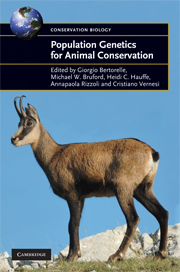Book contents
- Frontmatter
- Epigraph
- Contents
- List of contributors
- Foreword
- Acknowledgements
- 1 Introduction
- Statistical approaches, data analysis and inference
- Molecular approaches and applications
- From genetic data to practical management: issues and case studies
- Future directions in conservation genetics
- Software index
- Species index (common name)
- Species index (Latin name)
- Subject index
Foreword
Published online by Cambridge University Press: 05 July 2015
- Frontmatter
- Epigraph
- Contents
- List of contributors
- Foreword
- Acknowledgements
- 1 Introduction
- Statistical approaches, data analysis and inference
- Molecular approaches and applications
- From genetic data to practical management: issues and case studies
- Future directions in conservation genetics
- Software index
- Species index (common name)
- Species index (Latin name)
- Subject index
Summary
The field of conservation genetics is evolving very quickly, due to both methodological and technical improvements. In this context, it is important that experts worldwide meet and share their knowledge about the latest theories and statistical developments. A group of scientists from the Centro di Ecologia Alpina (Trento) and the University of Ferrara decided to organize a meeting on Population Genetics for Animal Conservation. This meeting was held on 4– September 2003 at the Centro di Ecologia Alpina, and included many famous population geneticists and conservation biologists. This book is the outcome of this meeting. It does not correspond to a classical and comprehensive textbook, but focuses on the latest developments in conservation genetics, in a well-organized and integrated unity.
When going through the different chapters, I realized that this book does not simply reflect the situation of conservation genetics in 2003. All the most recent developments are included. I particularly appreciate that the authors of some chapters did not hesitate to share their feeling about the future of conservation genetics. Such views are usually excluded from scientific papers due to the peer-review process that promotes only well-accepted theories and methods. This is unusual in such a manual, but will be extremely useful to scientists having to design a research strategy for the next few years.
I am convinced that this volume complements extremely well the existing general textbooks on conservation genetics, and will stimulate the development of innovative studies in population genetics applied to the conservation of threatened populations or species.
- Type
- Chapter
- Information
- Population Genetics for Animal Conservation , pp. xiiiPublisher: Cambridge University PressPrint publication year: 2009



